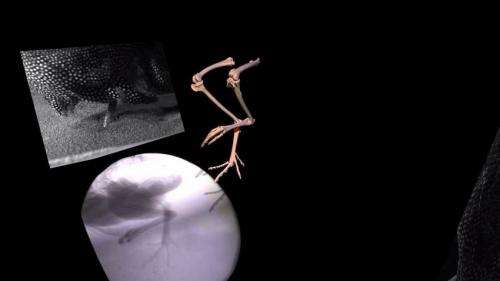(Phys.org)—A pair of researchers with Brown University used X-ray video techniques to capture the way a guineafowl makes tracks as part of a project aimed at learning more about preserved dinosaur footprints. In their paper published in Proceedings of the National Academy of Sciences, Peter Falkingham and Stephen Gatesy describe how they created their videos and what they learned by watching them and comparing what they found to real dinosaur tracks.
Scientists have been studying dinosaur tracks for many years, but up till now, they were forced to take them at face value, which offered little in the way of understanding the animal that left them. In this new effort, the research pair used a guineafowl as a stand-in for a similarly sized dinosaur (Corvipes lacertoideus) who left its tracks in a bit of sediment some 250 million years ago. Their efforts were part of work being done by Falkingham as a research fellow with the University of London's Royal Veterinary College. He and his partner wanted to find out what happens exactly, as a footprint is made on soft material.
When a footprint is made on a hard surface, such as a person walking through a puddle on a road, the print left behind is a reasonable facsimile of the size and shape of the foot, but when it's a soft material underfoot there are a variety of factors that can influence the print left behind—changes in foot shape, movement of the material being trod upon, etc. To take all these factors into consideration, the researchers placed a bed of poppy seeds inside an enclosure that had been fitted with X-ray video equipment. When a guineafowl was placed inside, the researchers were able to capture the movement of the bird's flesh and bones and also the movement of the seeds, as the bird walked. They then fed what they'd captured into a computer video simulator to show all of the parts working together. In studying what they'd captured, they found that while the print was nearly nonexistent when viewed at the surface, it was clearly visible nearly a half inch below, due, they noted, to the way the seeds collapsed as the bird removed its foot.
XROMM scene of guineafowl traversing poppy seeds. The 3D motions are captured where the X-ray beams (blue and yellow) intersect. A photogrammetric model of the final track surface is incorporated into the 3D world space. Speed slowed 10x. Credit: PNAS, doi: 10.1073/pnas.1416252111
The pair also found that the prints that were left behind were not shaped like the real foot, because the bird spread its toes as it set them down, then brought them together again as it lifted, creating a pattern scientists have seen before with dinosaur tracks. The researchers suggest their technique allows for gaining more information about how tracks are made and thus can shed light on how dinosaurs really moved as they walked.
Discrete element simulation of guineafowl traversing poppy seeds. Speed slowed 10x. Credit: PNAS, doi: 10.1073/pnas.1416252111
More information: The birth of a dinosaur footprint: Subsurface 3D motion reconstruction and discrete element simulation reveal track ontogeny, Peter L. Falkingham, PNAS, DOI: 10.1073/pnas.1416252111
Abstract
Locomotion over deformable substrates is a common occurrence in nature. Footprints represent sedimentary distortions that provide anatomical, functional, and behavioral insights into trackmaker biology. The interpretation of such evidence can be challenging, however, particularly for fossil tracks recovered at bedding planes below the originally exposed surface. Even in living animals, the complex dynamics that give rise to footprint morphology are obscured by both foot and sediment opacity, which conceals animal–substrate and substrate–substrate interactions. We used X-ray reconstruction of moving morphology (XROMM) to image and animate the hind limb skeleton of a chicken-like bird traversing a dry, granular material. Foot movement differed significantly from walking on solid ground; the longest toe penetrated to a depth of ∼5 cm, reaching an angle of 30° below horizontal before slipping backward on withdrawal. The 3D kinematic data were integrated into a validated substrate simulation using the discrete element method (DEM) to create a quantitative model of limb-induced substrate deformation. Simulation revealed that despite sediment collapse yielding poor quality tracks at the air–substrate interface, subsurface displacements maintain a high level of organization owing to grain–grain support. Splitting the substrate volume along "virtual bedding planes" exposed prints that more closely resembled the foot and could easily be mistaken for shallow tracks. DEM data elucidate how highly localized deformations associated with foot entry and exit generate specific features in the final tracks, a temporal sequence that we term "track ontogeny." This combination of methodologies fosters a synthesis between the surface/layer-based perspective prevalent in paleontology and the particle/volume-based perspective essential for a mechanistic understanding of sediment redistribution during track formation.
Journal information: Proceedings of the National Academy of Sciences
© 2014 Phys.org






















